Covered in this section is a free mock theory test. The DVSA multiple choice theory test for car drivers and motorcycle riders consists of 50 questions.
Many of the questions will require one answer, while others may require two or more. Before the question, you’ll be informed on how many answers are required. Simply use your computer mouse or touch which answer or answers you think are correct.
Some multiple choice questions will be presented as a case study. Case studies are a set of circumstances to replicate a real life situation. You’ll then be asked questions based on the scenario. See theory test case study for an example.
You will be given 57 minutes to complete the multiple choice of the theory test. To pass this mock test and the real theory test, you need to correctly answer 43 out of the 50 questions (86%).
Any question that you are unsure of, you can select the ‘Review question’ button and come back to it later. Unlike the real theory test, you will provided with hints during this mock theory test (except for the Case Study.)
Only use the hints if you are unable to answer the question. At the end of the test, select ‘Quiz Summary’ to review any questions that you may have answered incorrectly.
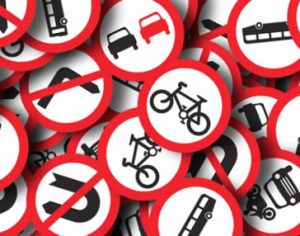
Mock Theory Test Question Set 1
Quiz-summary
0 of 50 questions completed
Questions:
- 1
- 2
- 3
- 4
- 5
- 6
- 7
- 8
- 9
- 10
- 11
- 12
- 13
- 14
- 15
- 16
- 17
- 18
- 19
- 20
- 21
- 22
- 23
- 24
- 25
- 26
- 27
- 28
- 29
- 30
- 31
- 32
- 33
- 34
- 35
- 36
- 37
- 38
- 39
- 40
- 41
- 42
- 43
- 44
- 45
- 46
- 47
- 48
- 49
- 50
Information
Select the ‘Start quiz’ button to begin.
You have already completed the quiz before. Hence you can not start it again.
Quiz is loading...
You must sign in or sign up to start the quiz.
You have to finish following quiz, to start this quiz:
Results
0 of 50 questions answered correctly
Your time:
Time has elapsed
You have reached 0 of 0 points, (0)
| Average score |
|
| Your score |
|
Categories
- Not categorized 0%
- 1
- 2
- 3
- 4
- 5
- 6
- 7
- 8
- 9
- 10
- 11
- 12
- 13
- 14
- 15
- 16
- 17
- 18
- 19
- 20
- 21
- 22
- 23
- 24
- 25
- 26
- 27
- 28
- 29
- 30
- 31
- 32
- 33
- 34
- 35
- 36
- 37
- 38
- 39
- 40
- 41
- 42
- 43
- 44
- 45
- 46
- 47
- 48
- 49
- 50
- Answered
- Review
-
Question 1 of 50
1. Question
Mark one answer
Whilst driving your mobile phone rings. Should you:
Correct
Incorrect
Hint
It is illegal to use hand-held mobile phone whilst driving. The safest option is to always turn off your mobile before driving. If you do need to make a call, pull up in a safe and legal place.
See using a mobile phone whilst driving for further information. -
Question 2 of 50
2. Question
Mark one answer
As a driver, what is the meaning of the flashing amber light at a Pelican crossing?
Correct
Incorrect
Hint
Pelican crossings are light controlled crossings that are activated by pedestrians. Unlike traffic lights, Pelican crossings have no amber-red phase before the green. Instead they have a flashing amber. At the flashing amber, you must give way to pedestrians who are already crossing. If the crossing is clear during the flashing amber stange, you may continue. For further information, see Pelican crossing.
-
Question 3 of 50
3. Question
Mark three answers
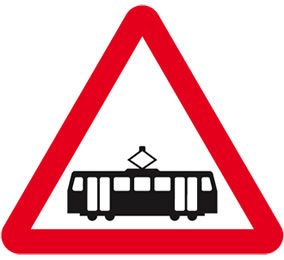
The vehicle in the picture is environmentally friendly for which reasons?
Correct
Incorrect
Hint
All trams are powered by electricity and as a result, no exhaust fumes are emitted. electric vehicles are also significantly quieter than petrol or diesel powered vehicles. Another benefit is due to their size, trams can carry large numbers of people.
-
Question 4 of 50
4. Question
Mark one answer
Whilst driving in windy conditions, extra care must be taken for:
Correct
Incorrect
Hint
Cyclists are easily blown off course by gusts of wind. Always give cyclists extra room during windy conditions.
-
Question 5 of 50
5. Question
Mark one answer
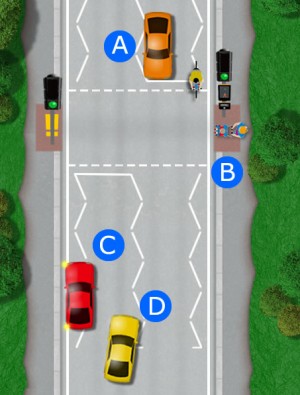
In this scene, which road user is causing a hazard?
Correct
Incorrect
Hint
It is illegal to park on the white zigzag lines on pedestrian crossings. Red car ‘C’ is causing a hazard because it is:
- blocking the view of the road for pedestrians that wish to cross
- blocking the view of the crossing for other drivers
-
Question 6 of 50
6. Question
Mark one answer
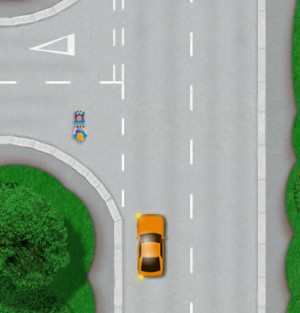
From the main road, you are making a left turn. Pedestrians are crossing the road in which you intend on turning into. You should:
Correct
Incorrect
Hint
Always approach turnings and junctions at an appropriate speed. Traveling at the correct speed will allow effective observations, including the road you intend on taking. Always give way to pedestrians already crossing the road. See making a left turn for further information.
-
Question 7 of 50
7. Question
Mark one answer
You are waiting at a minor junction to emerge right. Approaching from the right is a large vehicle. There is time to pull out and make the turn, but you should wait. Why?
Correct
Incorrect
Hint
Vehicles that overtake large vehicles can be traveling at speed and can easily be hidden. Always be aware of hidden vehicles.
-
Question 8 of 50
8. Question
Mark three answers
Choose three situations where you may overtake another vehicle on the left.
Correct
Incorrect
Hint
Many towns and cities experience ‘rush hour’ traffic. During these times of the day when traffic is heavy, you may overtake on the left only when traffic is moving slowly in queues and the lane to your right is moving slower than your lane.
-
Question 9 of 50
9. Question
Mark one answer
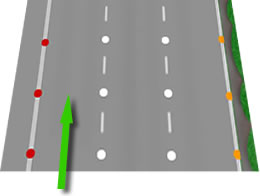
On a three lane motorway, what is the left-hand lane used for? Is it for:
Correct
Incorrect
All traffic should use the left-hand lane on a motorway except when overtaking, where the centre or right-hand lane may be used. When you have finished overtaking, safely move back over to the left-hand lane. Frequent use of mirrors is essential.
Hint
All vehicles must enter a motorway using the left-hand lane. Middle and right-hand lanes are for overtaking only and vehicles should move back to the left lane.
-
Question 10 of 50
10. Question
Mark one answer
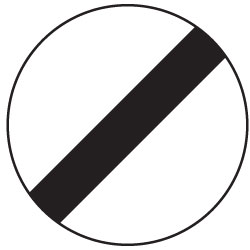
What does this road sign mean?
Correct
Incorrect
Hint
The national speed limit is dependent on the road you are on and varies from road-to-road.
-
Question 11 of 50
11. Question
Mark one answer

Road signs that give orders are usually which shape?
Correct
Incorrect
Hint
Circular road signs give orders. The only exception is the octagonal shape of the stop sign. It is an offence to not obey signs giving orders.
-
Question 12 of 50
12. Question
Mark one answer
Before you are legally permitted to drive on a public road, which of these must you have?
Correct
Incorrect
Hint
You must have a valid driving licence before using a vehicle on a public road. Driving without a valid licence is illegal and results in penalty points on your licence and a fine.
-
Question 13 of 50
13. Question
Mark two answer
You would normally inflate your car tyres to the recommended pressures. On which two occasions might you inflate your tyres to more than the recommended pressure?
Correct
Incorrect
Hint
Recommended tyre pressures are provided in your vehicle owners handbook and are also often displayed on the inside door pillar. Tyre pressures are lower during cold weather. You may need to increase tyre pressure whilst carrying a heavy load.
-
Question 14 of 50
14. Question
Theory Test Case Study 1.0
You’re planning to visit and spend the day with a friend who lives three hours drive away. You have a full tank of fuel and have checked the tyre pressures. Before you set off, you have further checks to make.
It’s early morning and as you begin your journey you notice that the road is still wet due to overnight rain.
During your journey, you’re on a single carriageway road and you notice a van that is traveling too close behind you.
You have reached the village where your friend lives. On a narrow village road with continuous double white lines in the centre, a cyclist is in front of you.
Arriving at your friends house, you park close by and facing downhill.
Question
Mark one answer
[ul type=help]- Before you set off on your journey, which other vehicle checks should be made?
[/ul]
Correct
Incorrect
-
Question 15 of 50
15. Question
Theory Test Case Study 1.1
You’re planning to visit and spend the day with a friend who lives three hours drive away. You have a full tank of fuel and have checked the tyre pressures. Before you set off, you have further checks to make.
It’s early morning and as you begin your journey you notice that the road is still wet due to overnight rain.
During your journey, you’re on a single carriageway road and you notice a van that is traveling too close behind you.
You have reached the village where your friend lives. On a narrow village road with continuous double white lines in the centre, a cyclist is in front of you.
Arriving at your friends house, you park close by and facing downhill.
Question
Mark one answer
[ul type=help]- Based on the current road condition, you should leave a time gap between vehicles of?
[/ul]
Correct
Incorrect
-
Question 16 of 50
16. Question
Theory Test Case Study 1.2
You’re planning to visit and spend the day with a friend who lives three hours drive away. You have a full tank of fuel and have checked the tyre pressures. Before you set off, you have further checks to make.
It’s early morning and as you begin your journey you notice that the road is still wet due to overnight rain.
During your journey, you’re on a single carriageway road and you notice a van that is traveling too close behind you.
You have reached the village where your friend lives. On a narrow village road with continuous double white lines in the centre, a cyclist is in front of you.
Arriving at your friends house, you park close by and facing downhill.
Question
Mark one answer
[ul type=help]- What should be done about the van?
[/ul]
Correct
Incorrect
-
Question 17 of 50
17. Question
Theory Test Case Study 1.3
You’re planning to visit and spend the day with a friend who lives three hours drive away. You have a full tank of fuel and have checked the tyre pressures. Before you set off, you have further checks to make.
It’s early morning and as you begin your journey you notice that the road is still wet due to overnight rain.
During your journey, you’re on a single carriageway road and you notice a van that is traveling too close behind you.
You have reached the village where your friend lives. On a narrow village road with continuous double white lines in the centre, a cyclist is in front of you.
Arriving at your friends house, you park close by and facing downhill.
Question
Mark one answer
[ul type=help]- What should you do about the cyclist?
[/ul]
Correct
Incorrect
-
Question 18 of 50
18. Question
Theory Test Case Study 1.4
You’re planning to visit and spend the day with a friend who lives three hours drive away. You have a full tank of fuel and have checked the tyre pressures. Before you set off, you have further checks to make.
It’s early morning and as you begin your journey you notice that the road is still wet due to overnight rain.
During your journey, you’re on a single carriageway road and you notice a van that is traveling too close behind you.
You have reached the village where your friend lives. On a narrow village road with continuous double white lines in the centre, a cyclist is in front of you.
Arriving at your friends house, you park close by and facing downhill.
Question
Mark one answer
[ul type=help]- You have left your vehicle parked facing downhill. The position of your front wheels should be:
[/ul]
Correct
Incorrect
-
Question 19 of 50
19. Question
Mark two answer
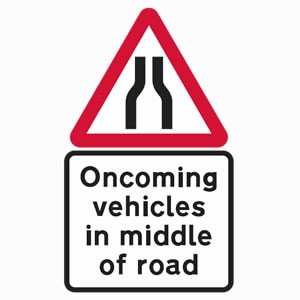
Whilst driving you see this sign up ahead. You should:
Correct
Incorrect
Hint
The road ahead is narrowing and is likely only wide enough for a single vehicle. Slow down and prepare to give way and wait for oncoming vehicles to clear the narrowing.
-
Question 20 of 50
20. Question
Mark one answer
What does ‘tailgating’ mean?
Correct
Incorrect
Hint
Tailgating is referred to a motorists that drives too close to the vehicle in front. Typically associated with fast moving traffic, tailgating significantly reduces thinking and braking distance and restricts the view of the road ahead.
-
Question 21 of 50
21. Question
Mark one answer
Why were ‘red routes’ introduced into major towns and cities?
Correct
Incorrect
Hint
Traffic lanes that are blocked impede the progress of vehicles causing delays. Slower moving traffic also increases fuel consumption and therefore produces more exhaust emissions. Red routes are placed in areas to prevent vehicles from stopping or waiting.
-
Question 22 of 50
22. Question
Mark one answer
Compared to normal dry conditions, the braking distance on ice is:
Correct
Incorrect
Hint
Braking distance on snow and ice can increase your braking distance by 10 compared to normal driving conditions.
-
Question 23 of 50
23. Question
Mark one answer
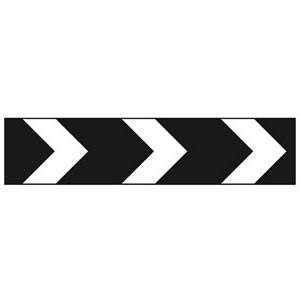
Whilst driving, you see this sign ahead. You will expect the road to:
Correct
Incorrect
Hint
This chevron sign warns of a sharp bend to the right. The opposite applies for a left-bend. Adjust your speed in good time.
-
Question 24 of 50
24. Question
Mark one answer
You intend on making a left turn into a side road. What hazard should you be aware of?
Correct
Incorrect
Hint
Pedestrians often cross the road at junctions. Always ensure you arrive before the junction at an appropriate speed and look into the road before making the turn. If pedestrians are crossing, slow or stop if necessary to give way.
-
Question 25 of 50
25. Question
Mark one answer
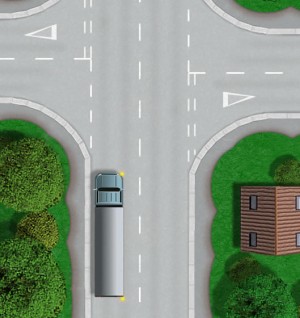
You are approaching a crossroads. In front of you is a long vehicle that is indicating to the right but moves over to the left-side of the road. What should you do?
Correct
Incorrect
Hint
Long vehicles that are turning need more room. The long vehicle turning right moves over to the left to avoid the trailer from cutting the corner as it turns.
-
Question 26 of 50
26. Question
Mark one answer
At an accident, a person has been injured and they may be suffering from shock. To check if this person is suffering from shock, you should look out for:
Correct
Incorrect
Hint
The warning signs of shock can include:
- Confusion or lack of alertness
- A sudden and ongoing rapid heartbeat
- Sweating
- Pale skin
- A rapid pulse
- Rapid breathing
-
Question 27 of 50
27. Question
Mark two answers
Whilst overtaking at night, which of the two following things should you do?
Correct
Incorrect
Hint
Visibility is significantly reduced at night. Only overtake if it’s absolutely necessary.
-
Question 28 of 50
28. Question
Mark one answer
What is the national speed limits on motorways for motorcycles and cars?
Correct
Incorrect
Hint
National speed limits are dependent on the type of road you are on. Dual carriageways and motorways has a national speed limit of 70 mph unless stated otherwise. Always use the left-hand lane on motorways and middle and right lanes for overtaking. Once finished overtaking, get back into the left lane.
-
Question 29 of 50
29. Question
Mark one answer
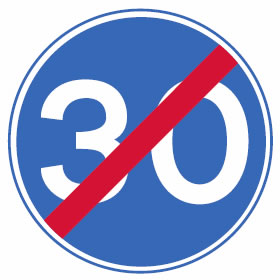
What is the meaning of this road sign?
Correct
Incorrect
Hint
The red dash through this sign informs you that the restriction of a minimum speed of 30 mph has ended.
-
Question 30 of 50
30. Question
Mark one answer
Signs giving orders must be obeyed. Order road signs are usually in:
Correct
Incorrect
Hint
Road signs in the shape of a circle give orders. Order road signs in a red ring are usually prohibitive. The exception is the octagonal stop sign. The stop sign uses this shape to make it more distinctive.
-
Question 31 of 50
31. Question
Mark one answer
As a newly qualified driver, you must have:
Correct
Incorrect
Hint
As a newly qualified driver, it is your responsibility to ensure you have adequate motor insurance.
-
Question 32 of 50
32. Question
Mark one answer
Whilst driving, you are stopped by a police officer and asked to show your documents. As you do not have them with you, you are required to produce them at a police station within:
Correct
Incorrect
Hint
It is not a legal requirement to take documents with you. If you do not have them, you’ll be required to produce them at a police station within 7 days.
-
Question 33 of 50
33. Question
Mark one answer
You are allowed to activate your hazard warning lights when:
Correct
Incorrect
Hint
Whilst moving, you must not use hazard warning lights. The exception to this is if driving on a motorway or dual carriageways to warn vehicles behind of slow or stationary up ahead. Do not use hazard lights when parking dangerously or illegally.
-
Question 34 of 50
34. Question
Mark one answer
What should the hard shoulder on a motorway be used for?
Correct
Incorrect
Hint
The hard shoulder of a motorway must only be used in emergencies. Stopping on the hard shoulder is dangerous. If you need to, stop as far from the carriageway as safely possible and wait outside the vehicle. Use the emergency telephone to report your problem. They will know your location and send help.
-
Question 35 of 50
35. Question
Mark two answers
You are driving on a three-lane motorway. It is busy but all three lanes are open. You are towing a small trailer. You must:
Correct
Incorrect
Hint
There are specific regulations for vehicles towing trailers. You must not use the right-hand lane of the motorway unless directed to do so. This could be due to road works and lane closures. Vehicles towing a trailer must not exceed 60 mph.
-
Question 36 of 50
36. Question
Mark one answer
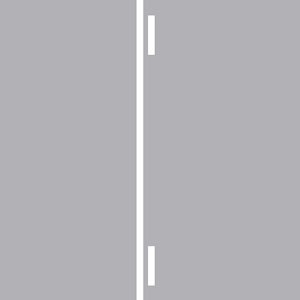
In the centre of the road, you see these road markings. What do they mean?
Correct
Incorrect
Hint
Solid white line on your side of the road means you must not cross the line except in certain circumstances. You are permitted to straddle or cross a continuous solid white line to enter a side road or property, to manoeuvre round a stationary vehicle blocking your side of the road, to overtake a cyclists, horse or a road works vehicle moving at 10 mph (16 km/h) or less.
-
Question 37 of 50
37. Question
Mark one answer
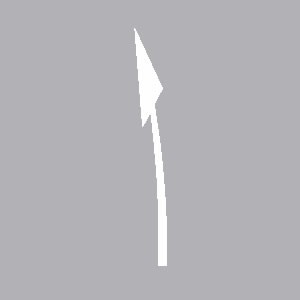
Whilst traveling, you see this road marking in the centre of the road. It warns:
Correct
Incorrect
Hint
These road markings are used in the centre of the road to warn overtaking drivers to move back over to the left due to hazards ahead. Hazards further down the road may include for example junctions, bends and dips in the road.
-
Question 38 of 50
38. Question
Mark one answer
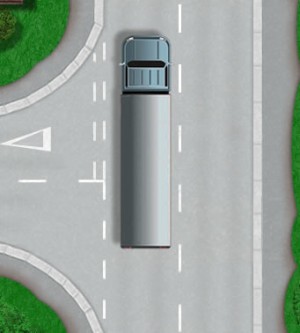
Following this vehicle too closely can be hazardous. Why?
Correct
Incorrect
Hint
Following any vehicle too closely is hazardous, large vehicles in particular. Following large vehicles too closely significantly reduces your view of the road ahead. Staying back allows you more time to react to any hazards ahead.
-
Question 39 of 50
39. Question
Mark one answer
Why do most modern vehicle come fitted with catalytic converters?
Correct
Incorrect
Hint
Vehicle that use petrol and diesel fossil fuels emit toxic fumes. Most modern vehicles are fitted with catalytic converters which help to filter toxic fumes.
-
Question 40 of 50
40. Question
Mark one answer
Your vehicle will use more fuel if your tyres are:
Correct
Incorrect
Hint
Under-inflated tyres use more fuel as they generate more resistance. More resistance means the engine needs to work harder. Check tyre pressures frequently, ideally around once every week. Recommended tyre pressure can be found in the vehicle handbook and can often be printed on a sticker inside the door pillar.
-
Question 41 of 50
41. Question
Mark one answer
In dry conditions, what is the stopping distance at 70 mph?
Correct
Incorrect
Hint
In good driving conditions, it’ll take 96 metres (315 feet) to stop at 70 mph. It takes significantly longer in poor weather conditions.
-
Question 42 of 50
42. Question
Mark three answers
You are driving past parked cars on a busy narrow street. Which potential hazards should you be aware of?
Correct
Incorrect
Hint
Pedestrians crossing the road between vehicles can be hard to see, especially children. Car doors opening on narrow streets are hazardous. Drivers pulling out of parking spaces often need to manoeuvre the vehicle before pulling out. You may need to stop to allow the driver to pull out.
-
Question 43 of 50
43. Question
Mark one answer
From the main road, you are making a right turn into a side road. Just before making the turn you should:
Correct
Incorrect
Hint
A motorcyclist may be traveling up behind you on the right-side. Your right indicator may be obscured by traffic. Always check your right door mirror before making the turn.
-
Question 44 of 50
44. Question
Mark two answers
You are following a bus. The bus pulls up at a bus stop. You should:
Correct
Incorrect
Hint
If possible, check to see how many people are waiting to get on the bus. If it looks as though the bus might be there for some time, pass the bus if it’s safe to do so. If you think the bus might be stopping for a short time only, wait and give way to the bus. Always watch carefully for pedestrians. Pedestrians may attempt to cross the road in front of the bus.
-
Question 45 of 50
45. Question
Mark one answer
What is traffic calming used for?
Correct
Incorrect
Hint
Road humps, chicanes, lower speed limits and various other techniques are used as traffic calming methods to lower the speed of vehicles. Vehicles that travel at low speeds means it’s safer for other road users and pedestrians.
-
Question 46 of 50
46. Question
Mark one answer
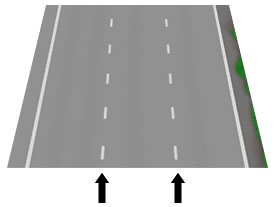
Between the lanes on a motorway are reflective studs. What colour are they?
Correct
Incorrect
Hint
Reflective studs on roads such as motorways are used as a visual aid, especially useful at night or during bad weather. The reflective studs between lanes are white and reflect the lights of your headlights.
-
Question 47 of 50
47. Question
Mark one answer
On dual carriageways, what is the national speed limit for cars and motorcycles?
Correct
Incorrect
Hint
Unless there are signs to tell you otherwise, the national speed limit for cars and motorcycles on dual carriageways and motorways is 70 mph.
-
Question 48 of 50
48. Question
Mark one answer
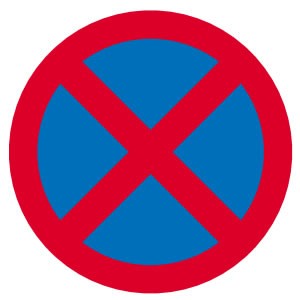
What does this road sign mean?
Correct
Incorrect
Hint
The red cross means no stopping, not even to pick up or set down passengers. This road sign is used to indicate a 24-hour clearway or may be incorporated into other signs with the words “No stopping”
-
Question 49 of 50
49. Question
Mark one answer
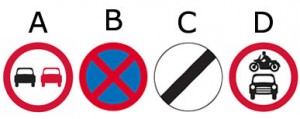
Which of the signs above means no motor vehicles permitted?
Correct
Incorrect
Hint
Sign ‘D’ no motor vehicles allowed is usually seen at the approach to a pedestrian-only zone.
-
Question 50 of 50
50. Question
Mark three answers
You have third party insurance cover on your vehicle. What does this type of insurance cover?
Correct
Incorrect
Hint
Third party vehicle insurance does not cover damage to your own vehicle or injury insurance to yourself. If you have an accident and it was your fault, third party insurance will cover the person(s) vehicle or property damaged and will cover other person(s) medical injury.
Most Difficult Theory Test Questions
Ever wondered which are the most difficult theory test questions that fail the most theory tests? Take a look, it’s not a quiz as the answers are supplied directly to you.
